Nestled in the gorgeous valley of Kashmir, Dal Lake is one of the most famous and stunning natural wonders of India. Dal Lake, sometimes called the “Jewel in the crown of Kashmir,” is more than just a body of water; it is an integral element of the area’s history and culture. Dal is a freshwater lake. The lake, which is surrounded by the magnificent Himalayas, is a must-visit location for tourists from all over the world because of its amazing natural beauty, extensive history, and lively local culture.
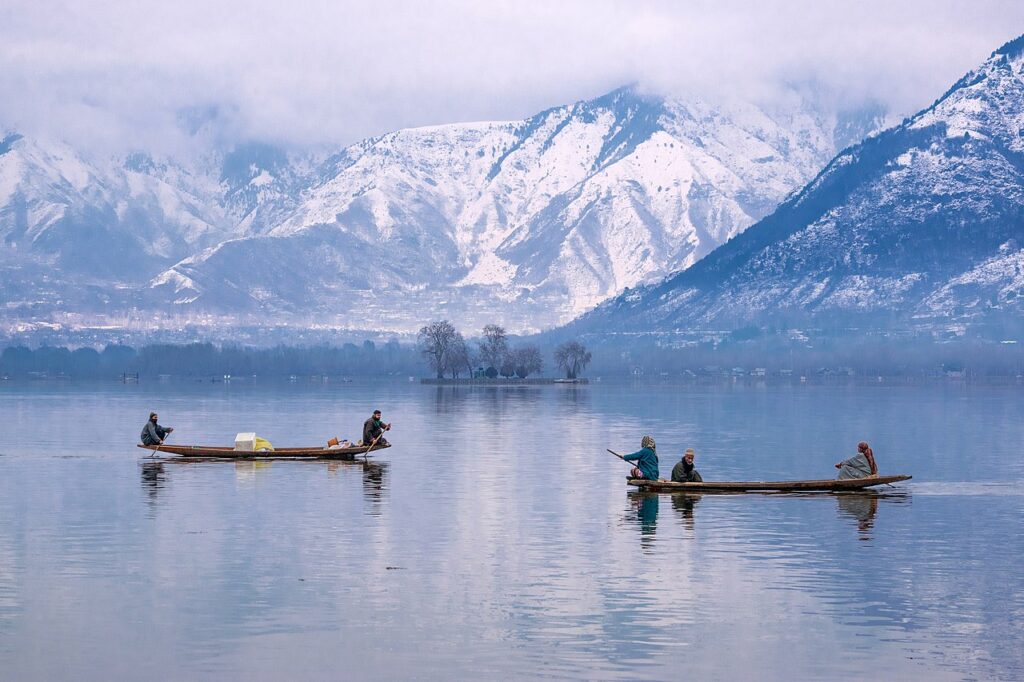
The Geography and Formation of Dal Lake
Dal Lake, nestled within the Srinagar district of Jammu and Kashmir, is one of the most picturesque and ecologically vital lakes in India. Often described as the “jewel of Srinagar,” it spans an area of approximately 22 square kilometers, though this fluctuates seasonally due to changes in water levels. Dal Lake is not a single, uniform water body; rather, it comprises four main interconnected basins—Gagribal, Lokut Dal, Bod Dal, and Nagin Lake—along with a series of narrow channels and floating gardens that together form its unique and intricate hydrological structure.
Geologically, Dal Lake is classified as a post-glacial lake, believed to have formed thousands of years ago as a remnant of the ancient Satisar Lake, which once covered much of the Kashmir Valley. The lake lies in a shallow bowl-like depression, surrounded by the Zabarwan Hills to the east, with snow-clad Himalayan peaks forming a majestic backdrop. These natural elevations contribute to the lake’s drainage pattern, as meltwater from snow and nearby streams, including the Dachigam Telbal Nallah, feed into the lake.
One of the lake’s most distinctive features is the presence of floating gardens, or Raadh, created from layers of aquatic vegetation and organic material. These serve both as agricultural plots and natural filters, playing a role in maintaining the lake’s ecological balance.
However, the geography of Dal Lake is not static. Over time, factors such as urban encroachment, siltation, and nutrient buildup have led to a gradual reduction in its size and depth. From about 25 square kilometers in the early 20th century, the lake has shrunk significantly, prompting concerns about its long-term sustainability.
History
The origins of Dal Lake date back to ancient times, with references found in texts as old as the Nilamata Purana, an ancient Kashmiri text. Various legends and myths associate the lake with sacredness and vitality, often regarding it as a vital water body in the region.
The lake gained prominence during the Mughal era in the 16th and 17th centuries. Akbar and Jahangir, the Mughal emperors, admired the beauty of Kashmir and often called it ‘Paradise on Earth.’ They contributed significantly to the development of the area around Dal Lake, constructing the famous Mughal gardens such as Shalimar Bagh, Nishat Bagh, and Chashme Shahi along its shores. These gardens are masterpieces of Mughal landscape architecture, blending Persian aesthetics with the natural beauty of the region.
During the Dogra rule in the 19th century, Dal Lake continued to be a prominent feature of Srinagar. The tradition of houseboats on the lake, which began during the British colonial period, became an iconic part of the lake’s identity. The British built houseboats on Dal Lake as floating homes, a tradition that continues to this day, because they were not allowed to own land in Kashmir.
Houseboats and Shikaras
Dal Lake is not just a stunning water body nestled in the heart of Srinagar—it is a vibrant, living experience shaped by its iconic houseboats and shikaras. These floating marvels are not only symbols of Kashmiri hospitality and culture but also the cornerstone of tourism on the lake.
Houseboats on Dal Lake are uniquely crafted wooden structures, richly carved and often adorned with traditional Kashmiri décor. Originally built to accommodate British visitors during the colonial era, who were not permitted to own land in Kashmir, these houseboats have since evolved into luxurious floating homes for travelers. Each one typically includes bedrooms, a dining area, bathrooms, and even private verandas, offering serene views of the lake. Staying on a houseboat gives visitors an intimate, immersive experience that blends comfort with tradition.
Complementing the houseboats are the shikaras—graceful, narrow wooden boats rowed by skilled boatmen. Often compared to the gondolas of Venice, shikaras serve multiple purposes on the lake. Tourists enjoy scenic rides through floating gardens, markets, and quiet waterways, while locals use them for transportation and commerce.People know these boats for their colorful canopies and cushioned seating, making every ride both relaxing and photogenic.
Together, houseboats and shikaras create an enchanting atmosphere on Dal Lake. They embody the rhythm of local life and provide a timeless connection to Kashmir’s cultural and historical roots, making a visit to the lake an unforgettable journey into the soul of the valley.
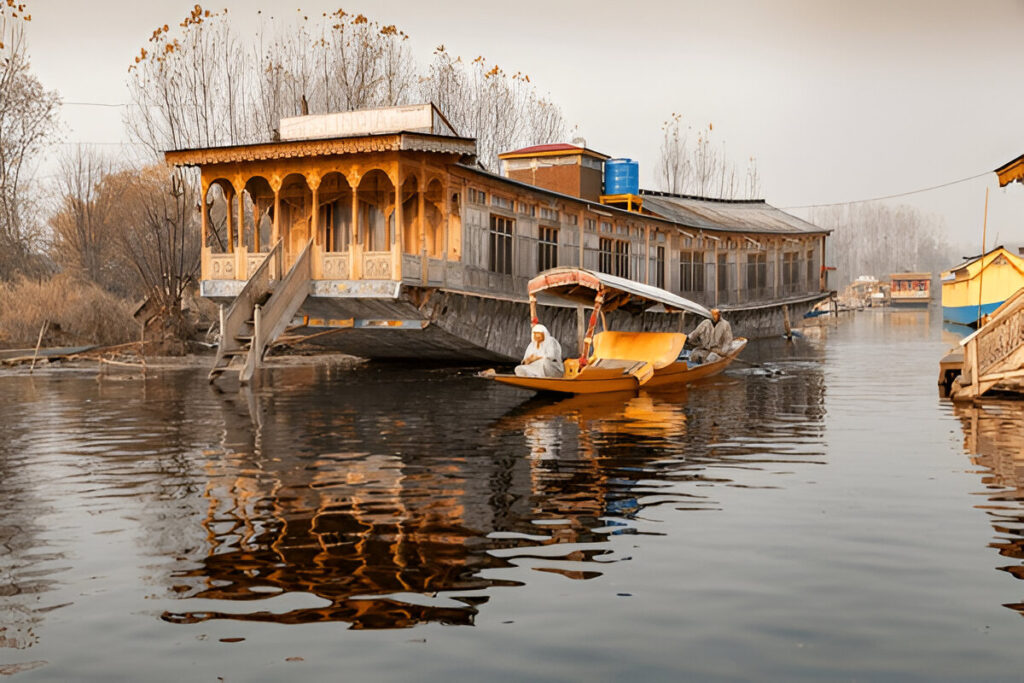
The Floating Gardens
One of the most fascinating and lesser-known features of Dal Lake is its floating gardens, locally known as “Rad” in Kashmiri. These gardens are a remarkable example of human ingenuity harmonizing with nature. Built upon layers of decaying vegetation and water weeds, these buoyant platforms float gently on the surface of the lake and are anchored with poles to prevent them from drifting.
The floating gardens are primarily used for growing vegetables, with tomatoes, cucumbers, pumpkins, and the famously crisp Kashmiri nadru (lotus stem) being common crops. Farmers cultivate these gardens with great care, planting seeds into the nutrient-rich layers and harvesting directly from the lake’s surface. To maintain buoyancy and soil quality, people regularly renew the gardens by adding more organic material, making them not only fertile but also sustainable.
In addition to providing fresh produce for local consumption and markets, the floating gardens play a key ecological role. They help absorb excess nutrients from the lake, contributing to its water quality. Farmers have passed down this agricultural technique through generations, and it continues to thrive despite the challenges of modern environmental changes.
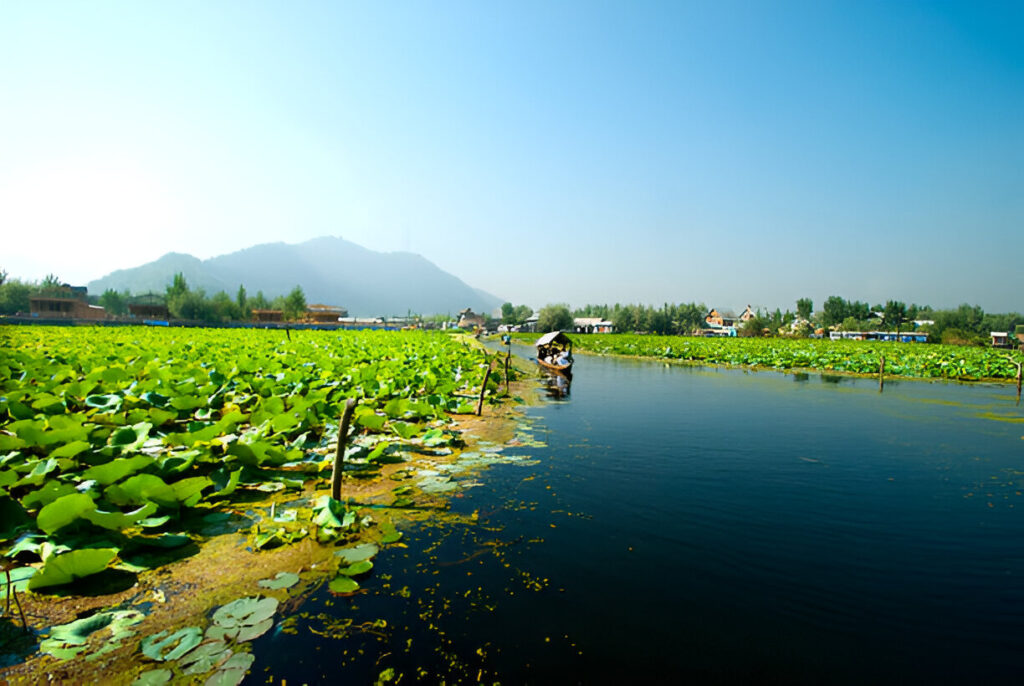
Mughal Gardens
Nestled along the serene banks of Dal Lake, the Mughal Gardens of Kashmir stand as a stunning blend of Persian elegance and natural splendor. Built during the reign of the Mughal emperors, particularly under Emperor Jahangir and later Shah Jahan, these gardens were designed to reflect the Islamic concept of paradise on Earth—a meticulously planned layout of terraces, flowing water, symmetrical plantings, and panoramic vistas.
Three of the most iconic Mughal Gardens bordering Dal Lake are Shalimar Bagh, Nishat Bagh, and Chashme Shahi. Each garden follows the classic charbagh (four-part) layout, with water channels fed by mountain springs running through the center, framed by manicured lawns, flowering shrubs, and majestic chinar trees. These water features not only enhance the beauty of the gardens but also create a cooling effect, which makes them a perfect summer retreat for royalty.
- Shalimar Bagh, the “Abode of Love,” was commissioned by Jahangir for his wife Nur Jahan and features terraced levels that lead the eye and spirit toward the lake.
- Nishat Bagh, meaning “Garden of Joy,” is larger and offers a breathtaking view of Dal Lake with the Zabarwan Mountains as a backdrop.
- Chashme Shahi, the “Royal Spring,” is known for its natural freshwater spring believed to have medicinal properties.
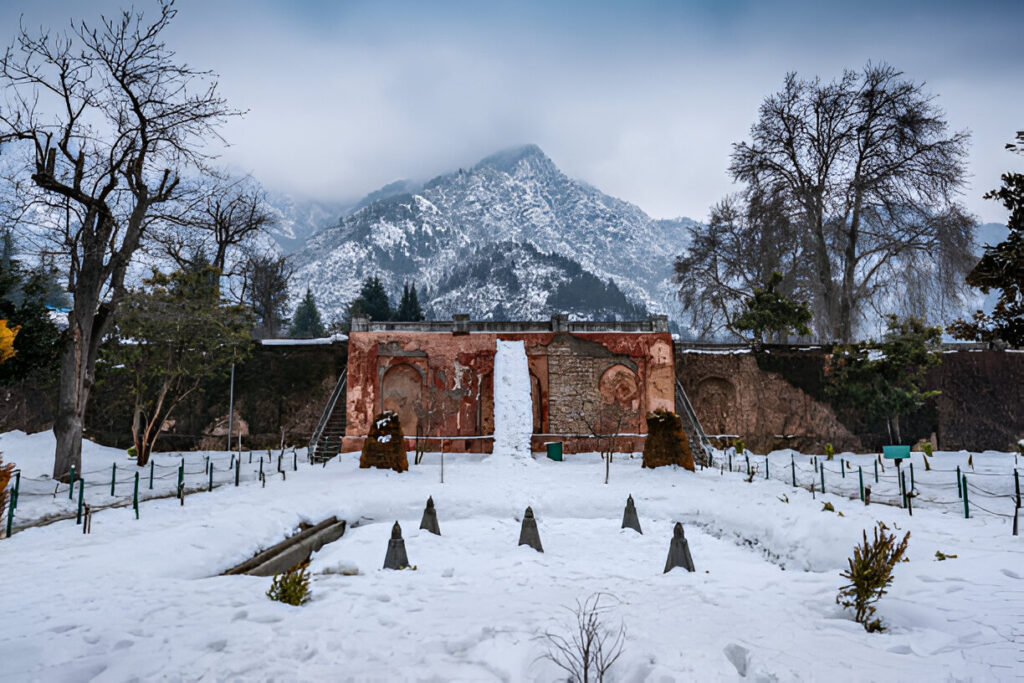
These gardens are not only horticultural masterpieces but also cultural symbols, showcasing the artistic vision and engineering skills of the Mughals. Their continued maintenance and popularity highlight their importance in Kashmir’s heritage and tourism. For visitors, a stroll through the Mughal Gardens is like stepping back in time, where royal grandeur meets the tranquil beauty of nature, all reflected in the mirror-like waters of Dal Lake.
Floating Post Office
The Floating Post Office is situated on Dal Lake, near Nehru Park in Srinagar, Jammu and Kashmir. It was inaugurated in August 2011 and is the only floating post office in India. The post office operates from a houseboat, which is a common sight on Dal Lake. The houseboat is decorated with traditional Kashmiri woodwork. It offers all standard postal services, including mail delivery, banking, and philately. It also has a small museum showcasing the history of postal services in the region. The Floating Post Office draws visitors who are intrigued by its unique concept and picturesque setting, making it a popular tourist attraction. This post office not only serves the local population but also symbolizes the resilience and adaptability of the postal services in the region.
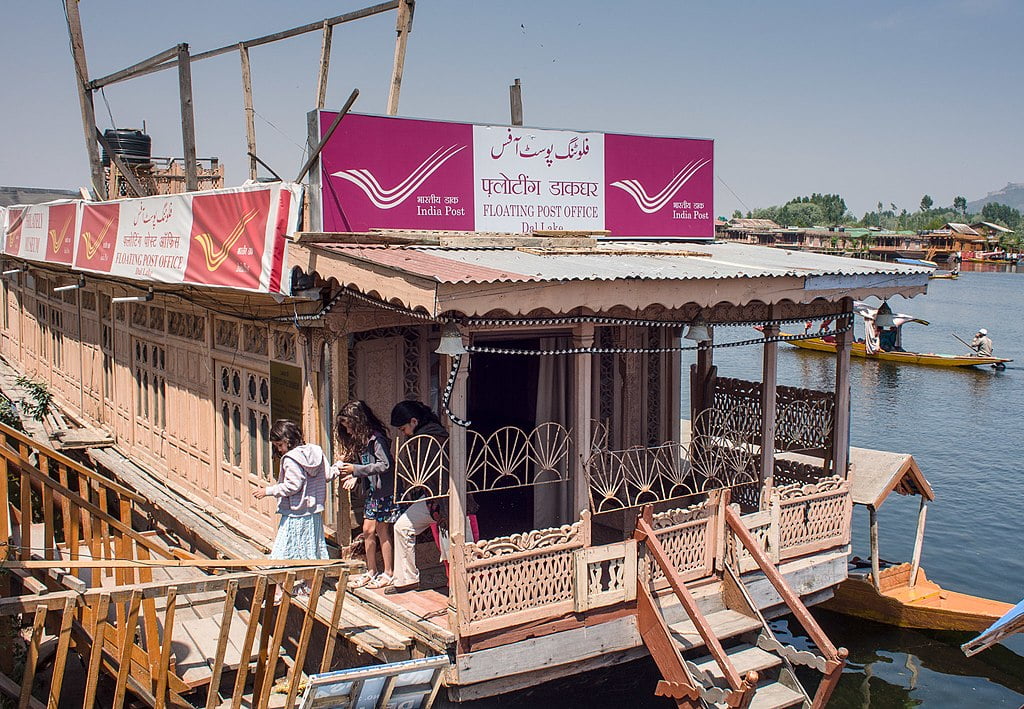
Best Time to Visit Dal Lake
The best time to visit Dal Lake in Kashmir is from March to October, when the valley comes alive with breathtaking natural beauty, pleasant weather, and vibrant local culture. This period spans spring, summer, and early autumn, each offering a unique experience to travelers.
Spring (March to May):
Spring is a magical season around Dal Lake. As the snow melts from the surrounding mountains, blossoming tulips, almond trees, and fresh greenery transform the landscape into a colorful canvas. The famous Tulip Garden near Dal Lake is in full bloom in April, drawing visitors from around the world. The weather is cool and crisp, ideal for shikara rides, garden strolls, and sightseeing.
Summer (June to August):
Summer is the peak tourist season in Srinagar, and Dal Lake becomes a hub of activity. Temperatures remain pleasant (between 15°C to 30°C), making it the perfect time for houseboat stays, boating, fishing, and shopping at the floating markets. The lake glistens under the summer sun, reflecting the surrounding hills and Mughal gardens in its calm waters.
Autumn (September to October):
Autumn brings a golden hue to the valley. The famous chinar trees around Dal Lake turn a fiery orange-red, creating a breathtaking contrast with the blue sky and serene lake. This is an excellent time for photographers, nature lovers, and those who enjoy a more peaceful atmosphere as the tourist rush begins to fade.
Winter (November to February):
Although not typically recommended for first-time travelers, winter has its own charm. The lake partially freezes during intense snowfall, and the surrounding peaks are draped in white. For adventure lovers and snow enthusiasts, this can be a quiet, offbeat time to explore a different side of Dal Lake, though many houseboats close during the coldest months.
Tourist Attractions Around Dal Lake
Dal Lake is not just a stunning water body; it’s the soul of Srinagar and the heart of Kashmir’s tourism. A wealth of tourist attractions showcasing nature, history, and local culture surrounds Dal Lake, nestled in the Himalayas. From enchanting Mughal gardens to bustling floating markets and ancient temples, there’s something for every traveler in the vicinity of Dal Lake.
1. Mughal Gardens
The famous Mughal Gardens—Shalimar Bagh, Nishat Bagh, and Chashme Shahi—are located along the shores of Dal Lake. Built by the Mughal emperors, these gardens are masterpieces of Persian landscaping, featuring cascading terraces, chinar trees, flower beds, and fountains. They offer breathtaking views of the lake with the Zabarwan Range in the background.
2. Hazratbal Shrine
Located on the northern banks of Dal Lake, the Hazratbal Shrine is one of the most revered Muslim sites in Kashmir. Its white marble architecture and serene setting make it not only a religious site but also a place of spiritual peace. The shrine houses a relic believed to be a strand of the Prophet Muhammad.
3. Shankaracharya Temple
Perched atop the Shankaracharya Hill, this ancient Hindu temple dedicated to Lord Shiva offers panoramic views of Dal Lake and Srinagar city. A short trek or drive leads you to this 2,000-year-old site, which also holds historical significance linked to Adi Shankaracharya’s visit to Kashmir.
4. Floating Vegetable Market
Dal Lake’s unique floating vegetable market, held in the early mornings, offers a rare cultural experience. Locals navigate wooden boats (shikaras) filled with fresh produce harvested from floating gardens. Tourists can witness live bargaining scenes and even buy some local products while drifting through the misty waters.
5. Nehru Park
Located on an island within Dal Lake, Nehru Park is accessible only via a shikara. It’s a peaceful retreat with well-manicured lawns, flowers, and excellent views of the lake and surrounding mountains. It’s also a great place for family picnics, photography, or just soaking in the calm.
6. Pari Mahal
The Pari Mahal, or “Palace of Fairies,” is a historic seven-terraced garden located on the Zabarwan mountain range overlooking Dal Lake. It was originally a Sufi observatory and Islamic learning center. Today, it offers magnificent sunset views and a quiet, offbeat attraction for history and nature lovers alike.
7. Botanical Garden and Tulip Garden
Close to Dal Lake are the Jawaharlal Nehru Botanical Garden and the Indira Gandhi Memorial Tulip Garden—Asia’s largest tulip garden. While the botanical garden is open year-round, the tulip garden opens only for a few weeks in spring (usually late March to mid-April), when rows upon rows of colorful tulips bloom against the snowy mountain backdrop.
8. Local Markets
The area surrounding Dal Lake is dotted with craft markets, where tourists can shop for authentic Kashmiri handicrafts—pashmina shawls, paper-mâché items, walnut wood carvings, and Kashmiri saffron. Notable markets include Lal Chowk, Polo View Market, and Residency Road.
9. Nigeen Lake
Often called the “sister lake” of Dal Lake, Nigeen Lake is quieter and less commercialized, offering a more tranquil shikara or houseboat experience. It’s ideal for those seeking peace and solitude amidst natural beauty.
10. Zabarwan Park and Light & Sound Show
Zabarwan Park, near the Mughal Gardens, is a well-maintained park with children’s play areas and a musical fountain. The Light and Sound Show, held during the tourist season, highlights the cultural history of Kashmir with visuals projected against the Dal Lake.
Challenges Facing
Despite its beauty and cultural significance, Dal Lake faces several environmental challenges. Pollution from untreated sewage, encroachment, and the growth of invasive plant species are some of the major issues threatening the lake’s ecosystem. Both the government and local communities are making efforts to restore and preserve the lake, but much work remains to be done to protect this natural treasure for future generations.
Conclusion
Dal Lake is more than just a scenic destination; it is the heart and soul of Kashmir. Its breathtaking beauty, combined with its rich cultural and historical heritage, makes it a must-visit location for anyone exploring the region. Whether you’re drifting on a Shikara, staying in a houseboat, or simply soaking in the views from a Mughal garden, a visit to Dal Lake is an experience that stays with you long after you’ve left its shores. As efforts continue to preserve and protect this magnificent lake, it remains a symbol of the enduring beauty and resilience of the Kashmir Valley.
Read also
- Physical Features of Kashmir
- Major Lakes in India
- Important facts about India
- Top Tourist Places in Kashmir
- India’s States and UTs: A Colorful Tapestry of Nicknames
- Stargazing in India: Top Places to See the Milky Way
- 10 Most Breathtaking Natural Wonders in the World
- Pune Couple’s Heroic Act: Oxygen Plant for Siachen Soldiers
- States and Capitals of India – 2024
- Important Mountain Passes in India
- India’s International Borders
- India’s UNESCO World Heritage Sites
- Himalayan Glaciology: Study of Glaciers in the Indian Himalayas
- Coastal Landscapes of Indian States and the Nation
- Chenab River Bridge: World’s Highest Railway Arch Bridge in India
Important Facts About Dal Lake, Kashmir
- Location: Dal Lake is situated in Srinagar, the summer capital of Jammu and Kashmir, India.
- Size and Depth: The lake covers an area of 18-22 square kilometers and has a maximum depth of about 6 meters.
- Shoreline: The shoreline of Dal Lake stretches approximately 15.5 kilometers and is lined with Mughal-era gardens, parks, houseboats, and hotels.
- Floating Gardens: Known as “Rad” in Kashmiri, the floating gardens on Dal Lake bloom with lotus flowers during July and August.
- Islands: The lake features several islands, including Char Chinar and Sona Lank, which are popular tourist spots.
- Historical Significance: Dal Lake is surrounded by Mughal gardens such as Shalimar Bagh and Nishat Bagh, built during the reign of Emperor Jahangir.
- Tourism and Recreation: The lake is a hub for tourism and recreation, offering activities like shikara rides, houseboat stays, and fishing.
- Environmental Efforts: Significant investments have been made to restore Dal Lake and address its eutrophication problems, with the Government of India investing around $275 million.
- Climate: During severe winters, the temperature around Dal Lake can drop to as low as -11°C, causing the lake to freeze.
- Cultural Importance: Dal Lake is often referred to as the “Jewel in the Crown of Kashmir” and is integral to the local culture and economy.
Frequently Asked Questions (FAQs)
Dal Lake is located in Srinagar, the summer capital of Jammu and Kashmir, India.
The best time to visit is from April to October when the weather is pleasant. July and August are particularly beautiful due to the blooming lotus flowers.
People use shikaras, traditional wooden boats, for transportation and tourism on Dal Lake. They often call them the “Gondolas of Kashmir”.
Floating Gardens, known locally as “Rad”, are unique agricultural platforms made by weaving together the roots of reed plants. They’re used to grow vegetables and flowers.
Popular activities include shikara rides, staying in houseboats, visiting floating markets, and enjoying the scenery, especially during sunrise and sunset.
Yes, Dal Lake hosts unique floating markets where vendors sell their goods from shikaras. These are popular tourist attractions.
Parts of Dal Lake can freeze during severe winter conditions, typically in December and January.





